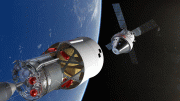
The 1725 Newsham fire engine inspired the authors to examine the Windkessel effect and capture the physics behind the enduring technology of a steady stream of water under pressure. Credit: Photo used courtesy of The Colonial Williamsburg Foundation. Museum Purchase
Stabilizing the flow of water in pumping systems marked a significant breakthrough in the 18th century.
Today, the technology behind water pressure is widespread, benefiting anyone who takes a shower, irrigates a garden, or combats fires. However, in the 17th and 18th centuries, a steady stream of water not punctuated by pressure drops was a major breakthrough.
In 1666, when bucket brigades were the best line of defense, the Great Fire of London burned almost all of the city’s tightly packed, wooden structures. The disaster destroyed hundreds of thousands of homes and dozens of churches, demonstrating the need for better firefighting methods and equipment.
Innovations in Firefighting
One landmark advancement was the invention of “sucking worms,” leather hoses attached to manually operated pumps. Then came the Windkessel, a chamber in the bottom of a wooden wagon that compressed air to pump water continuously through a hose, creating a steady stream.
Inspired by a 1725 fire engine that pumped water at larger distances and higher speeds than previously possible, authors publishing in the American Journal of Physics, by AIP Publishing, analyzed the pressure chamber’s Windkessel effect to capture the physics behind this widely used, enduring technology.
“There are many fascinating physics problems hiding in plain sight within books and papers written centuries ago!” author Trevor Lipscombe said. “Recently we’ve been working on applying elementary fluid mechanics to biological systems, and came across a common description in medical journals: that the heart acts as a Windkessel. That begs the question of what, precisely, is a Windkessel? Following the trail, we found descriptions of Lofting’s ‘sucking worm’ device and, in Newsham’s fire engine, a lifesaving application.”
Physics and Firefighting Equipment
To pinpoint what factors are most influential in the Windkessel effect, the authors compared the initial state of the chamber, the rate at which bucket brigades could pour water in (volumetric inflow), the length of time pressure builds, and the effects on output flow rate.
“When faced with Lofting’s design, or the Newsham fire engine, a physicist wants to sort out the basic science involved – simply because it’s there,” Lipscombe said. “It’s the joy of doing physics. But also, there’s a pedagogical aspect. Our article builds a simple model that shows how a Newsham fire engine works. We’re partly answering the ‘when will I ever use this stuff?’ question.”
Next, the authors plan to examine the physiological Windkessel involved in the heart-aorta system.
“Knowledge of Bernoulli’s law, the ideal gas law, and isothermal expansion are the three ingredients we baked into a model to explore how this device worked,” Lipscombe said. “But if we understand this system better, we could look at the parameters that are important and see how changing them might improve the device.”
Reference: “From sucking worms to Windkessel: The physics of an early eighteenth century firefighting device” by Don S. Lemons and Trevor C. Lipscombe, 1 February 2024, American Journal of Physics.
DOI: 10.1119/5.0147573









Knowledge of Bernoulli’s law, the ideal gas law, and isothermal expansion are the three ingredients they baked into a model to explore how this device worked. Ideal fluids are everywhere, just like the so-called neutrinos, but they cannot be detected.
The gravitational point of topological vortices is a point defect in spacetime. According to topological vortex gravitational field theory, the interaction between the gravitational points of topological vortices is ubiquitous. Mass, inertia, and various forms of energy are different manifestations of the interaction between the gravitational points of topological vortices. There is no eternal mass, only eternal fluid mechanics.
Science must follow mathematical rules. For example, the Standard Model (SM) is considered to be one of the most significant achievements of physics in the 20th century. However, the magnetic moment of μ particle is larger than expected, revealed by a g-2 experiment at Fermilab, suggests that the established theory (such as SM) of fundamental particles is incomplete. Furthermore, the SM omitting gravity, it not involved the time problem and when the particle movement starts. Mathematics is the foundation of science. Physics must respect the scientific nature of mathematics and mathematical models. The SM must be based on mathematical models in order to be scientific, convincing, and in line with natural laws.
I hope researchers are not fooled by the pseudoscientific theories of the Physical Review Letters (PRL), and hope more people dare to stand up and fight against rampant pseudoscience.
The so-called academic journals (such as Physical Review Letters, Nature, Science, etc.) firmly believe that two high-dimensional spacetime objects (such as two sets of cobalt-60) rotating in opposite directions can be transformed into two objects that mirror each other, is a typical case of pseudoscience rampant.
If researchers are really interested in Science and Physics, you can browse https://zhuanlan.zhihu.com/p/643404671 and https://zhuanlan.zhihu.com/p/595280873.